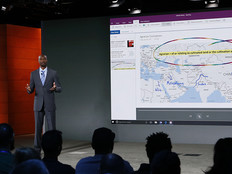Answering the Call: Unified Communications Updates Aging Telephone Systems
Schools turn to unified communications to centralize telephone and messaging management.
Henry Knoch, technology consultant for Rapid River Public Schools in Michigan, needed a more efficient way to manage the district's communications.
Rapid River was using a school telephone system based on an aging private branch exchange that required a lot of hands-on work adding lines and changing extensions. The district also was inundated with a growing number of requests for more messaging functionality from staff and teachers.
Knoch's answer: Deploy a unified communications system. With UC, “we can now manage the telephone system more effectively,” he says. It sounds simple, but in a world with shrinking staff and increasing workloads, it's no small feat if you're the go-to guy for telephone services for dozens of teachers and administrative employees.
Knoch is not alone among K–12 IT administrators when choosing this kind of system. The wave of advancing IP-based telephony combined with the rising tide of messaging channels is driving school districts to rethink their aging telephone and intercom systems in favor of more flexible IP-based solutions. These systems can tie their various advanced messaging and telephone capabilities together and also open up new, previously unimagined avenues for administrators, teachers and students.
What's In A Name?
UC technology ranges from simple IP telephone and messaging systems to complex IP-based systems that fuse voice, data and video platforms, says Blair Pleasant, president and principal analyst of market research firm COMMfusion. UC systems offer a smorgasbord of messaging, voice and video capabilities using technology that includes telephone switches, desktop applications, mobility products, and conferencing and collaboration tools.
Although UC means different things to different people, it's clear that K–12 administrators want to make messaging and communications as seamless as possible for everyone they serve to save money and promote efficiency.
According to Pleasant, there are two types of UC systems: those that focus on user productivity and those that focus on business processes. For any system to be effective, however, it must be tied into business processes, where it can reduce human error and time lags, Pleasant says.
Easing the Workload
Knoch, who works onsite at Rapid River's K–12 Tri-County School three days a week, doesn't have the luxury of nursing along an outdated system. With a small staff, he longed to reduce the costs of POTS (plain old telephone service) and do away with the manual work required to change telephone lines for teachers and administrators who relocated classrooms or offices.
Knoch installed a Shoretel VoIP system that implements vastly improved call control through 70 Shoretel 230 IP phones in classrooms. The phones display who is calling and who has called, which aids teachers in prioritizing return calls to parents and administrators.
In addition to call history, the new phones have call waiting and speaker functions, which the old phones didn't have. Also, IP phone numbers and locations can be centrally controlled, with no need to physically rearrange extensions when teachers move to different classrooms. Within classrooms, telephones are no longer physically wired to an immovable wall jack and can be carried freely about the room.
“The call-handling capabilities alone will probably save $500 to $700” per year, Knoch says. “There is no longer a need to invest time and effort to physically move phone extensions or reassign them.”
Keeping Up Communications
San Ramon Valley Unified School District in California used Cisco Systems' Unified Communications system to help its rapidly expanding facilities keep pace with telephone requirements. In the past two years, the district has added three new elementary schools to its roster of 32 schools, says Peter Campopiano, coordinator for technical support and system administration.
The number of mobile messages delivered worldwide in 2008
SOURCE: “CfA Commons” (Code for America, March 2014)
The district installed 1,000 IP phones in 22 of its schools and plans to roll them out at the remaining 10 in the coming months, Campopiano says. The district also has used the UC technology to establish an intra-district IP telephone network that lets teachers and administrators dial other schools without going through local telephone services.
San Ramon Valley also used UC to establish a single data network when three of its schools were demolished and rebuilt. The Cisco product allowed a single network to support the three schools' IP classroom clocks and speaker systems, Campopiano says. He was able to transfer the network services to the temporary buildings that the district used while the new schools were being built and then shifted the service again once the new facilities were completed. The application allowed immediate and less costly implementation of the system in all three new schools, he says.
Game Changer
At Norwood School in Bethesda, Md., David Rossell, administrator of network services and planning, implemented an Avaya IP Office 500 telephony package as the foundation for a messaging system. Rossell combined voicemail, e-mail and fax capabilities in his administrators' BlackBerry devices and extended direct telephone and fax numbers to the school's teachers. He also provided message-waiting notification lights on teachers' phones.
“I've had some school administrators tell me it changed their lives,” Rossell says.
The new unified messaging system is linked to his school's Microsoft Exchange Server, letting him store voice messages, e-mail and faxes in the same place. Because the system stores voice messages as .wav files, users can access them over the Internet through e-mail anywhere in the world.
Full Integration
Students at Hoover City Schools in Jefferson County, Ala., near Birmingham, can collaborate with students in similar classes across the district, or conduct surveys of other Hoover City Schools using a newly installed UC system. Hoover City teachers can transmit assignments to students' computers and share assignment information and review materials with parents, says chief technology officer Keith Price.
The district has established a foundation for unified communication with Microsoft Exchange and Microsoft Office Communications servers and is emphasizing the benefits of UC to its staff, teachers, parents and students, Price says. By replacing its old voice-mail system with the UC servers, the district has saved about $150,000, he says.
Hoover City Schools also hopes to do more than just combine voicemail and e-mail messaging functions, Price says. UC also provides instant messaging, desktop video and voice conferencing using Microsoft office communicator. The office communicator client on the district's servers lets users throughout the district communicate through the server instead of using outside telephone lines or the Internet. This lowers costs for the schools, he says.
The capabilities also let classrooms communicate with one another, opening new avenues for learning, in addition to saving money. “It allows kid-to-kid collaboration,” Price says. “Students can share opinions through surveys about their school's food, political views and other things.”
5 Components to Unity
Generally, unified communications offers five core capabilities and combines them in some fashion:
- Messaging: instant messaging and e-mail
- Conferencing and Collaboration: web video and white-board applications
- Mobility: extending the enterprise network telephone system to mobile networks
- Call Control on the Network: call parking; call forwarding; and flexible number assignments, including adds, drops and changes
- Presence: allows network users to see others who are currently using the system, which facilitates communication among users. If a user is on e-mail, then a buddy list can notify other users to send a message to that user.







